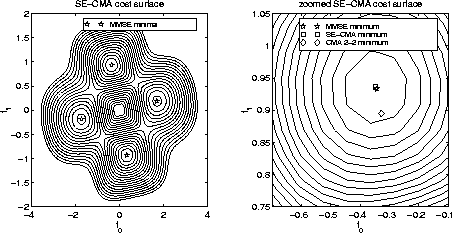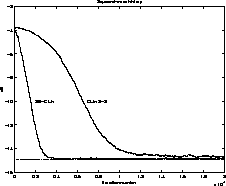


Next: Two-tap equalizer with six-tap
Up: Simulation Results
Previous: Simulation Results
Consider the communications system in Figure 1 with an i.i.d. BPSK source,
the channel
![$\ensuremath{\mathbf{c}}=\left[\begin{array}
{cccc}0.2&0.5&1&-0.1\end{array}\right]^T$](img34.gif) ,
and a two-tap FSE (Nf=2).
,
and a two-tap FSE (Nf=2).
Figure 2:
SE-CMA cost contours for BPSK source, 15 dB SNR
 |
Figure 2a shows the SE-CMA cost contours
for this system when the SNR is 15 dB. Figure 2b is a zoomed version
of Figure 2a that shows the locations of the optimal MMSE, SE-CMA, and
CMA 2-2 minima overlaid on the SE-CMA cost surface. As can be seen, the
SE-CMA minimum is closer to the MMSE minimum than is CMA 2-2.
A numeric simulation was also performed to prove that the SE-CMA equalizer
attains lower error than the CMA 2-2 equalizer. For 20,000 iterations with
 , a portion of the squared-error history
is shown in Figure 3.
, a portion of the squared-error history
is shown in Figure 3.
Figure 3:
Comparison of error history for SE-CMA and CMA 2-2 (BPSK, SNR=15dB)
 |
The SE-CMA error levels off at about -14.85 dB, whereas the CMA 2-2 error only gets
to about -14.65 dB. Therefore, I have shown for this BPSK system
that the more efficient SE-CMA is superior to the more common CMA 2-2.



Next: Two-tap equalizer with six-tap
Up: Simulation Results
Previous: Simulation Results
Andrew Grant Klein
8/12/1998
![]() ,
and a two-tap FSE (Nf=2).
,
and a two-tap FSE (Nf=2).
![]() , a portion of the squared-error history
is shown in Figure 3.
, a portion of the squared-error history
is shown in Figure 3.